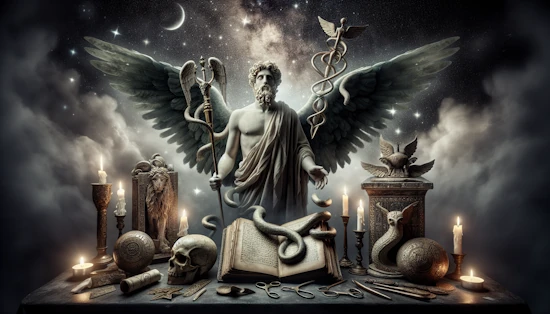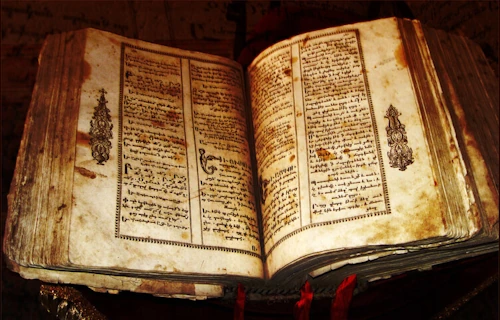Hermes Trismegistus emerges as a central figure in the annals of mythology and spirituality, blending the wisdom of the Greek god Hermes with the Egyptian deity Thoth. As a cornerstone of hermetic philosophy, his teachings, encapsulated in texts like the Corpus Hermeticum, navigate the complex terrains of cosmos, alchemy, and revelation, offering insights into the symbiotic relationship between the physical and ethereal realms. This ancient sage, known also as Thrice Great, casts a long shadow across the ages, from antiquity to the modern fascination with mysticism and the perennial quest for knowledge that transcends the ordinary bounds of understanding.

The legacy of Hermes Trismegistus extends beyond mere mythology, influencing a vast array of disciplines from hermetic tradition to western esotericism. His principles, enshrined in hermetic texts, articulate a vision of the world where divine wisdom and mortal curiosity converge, guiding seekers through the intricacies of alchemy, Kybalion, and the mysteries of the divine. This article offers an in-depth examination of the multifaceted impact of his teachings on Renaissance thought, Islamic and Baháʼí traditions, and contemporary spiritual quests for unity between humanity and the cosmos.
The Origins of Hermes Trismegistus
Hermes Trismegistus, a figure of immense significance in Western esoteric tradition, originated from a syncretic fusion of the Greek god Hermes and the Egyptian god Thoth. This amalgamation occurred during the Hellenistic period in Egypt, a time marked by the blending of Greek and Egyptian cultures following the conquests of Alexander the Great. The Greeks, recognizing similarities between their god of wisdom, Hermes, and the Egyptian deity Thoth, known for his roles as a scribe and wisdom keeper, merged these figures into one, creating Hermes Trismegistus or “Thrice-Great Hermes,” echoing the epithet of Thoth found at the Temple of Esna.
The interpretatio graeca, a common practice of the Greeks involving the synchronization of gods from different cultures, facilitated this cultural synthesis. In addition to being regarded as a deity of wisdom, Hermes Trismegistus was also credited with the creation of various forms of knowledge, including astrology, alchemy, and theology. This broad spectrum of influence is reflected in the Hermetic texts, which are divided into two main categories: the more widely accessible popular Hermetism, which includes astrology and other esoteric sciences, and the more scholarly learned Hermetism, focusing on deeper theological and philosophical issues.
These Hermetic writings, particularly the 17 treatises of the Corpus Hermeticum, along with significant fragments preserved in Stobaeus and the Latin Asclepius, were foundational in the spread of Hermetic thought. Originating primarily in the early centuries CE, these texts underscore the philosophical and spiritual inquiries of the time, emphasizing a cosmos where all components are interlinked. This notion of unity and interdependence not only shaped the astrological and alchemical studies of the era but also had a profound impact on later intellectual traditions, including those of the Arabs and the Renaissance scholars in the West.
The Corpus Hermeticum and Hermetic Texts
The Corpus Hermeticum, a foundational collection of writings, is traditionally attributed to Hermes Trismegistus and serves as the cornerstone of Hermetic philosophy. Composed between the 1st and 3rd centuries CE, these texts delve into various subjects, including philosophy, alchemy, and theology. They reflect a profound engagement with the divine and the cosmos. The collection, comprising seventeen treatises, examines the nature of the divine, the cosmos, and the human soul, with a particular emphasis on a monistic worldview wherein all existence is interconnected through the divine.
The Hermetic tradition is centered on texts such as Poimandres and Asclepius. Poimandres, often regarded as the inaugural treatise, presents a creation narrative wherein the cosmic Mind, or Nous, bestows gnosis, or spiritual knowledge, upon Hermes, thereby exemplifying the process of human enlightenment and the realization of divine oneness. On the other hand, Asclepius discusses the animation of statues, suggesting that through certain rites, objects could be imbued with life, reflecting the Hermetic view on the power of the Word and ritual in bridging the material and spiritual worlds.

The rediscovery of these texts during the Renaissance profoundly influenced Western thought, reintroducing ancient wisdom that challenged contemporary religious and philosophical understandings. The translation of the Corpus Hermeticum into Latin by Marsilio Ficino, commissioned by Cosimo de Medici, marked a pivotal moment in this revival, fueling the Renaissance’s intellectual fervor and its subsequent cultural movements. This resurgence underscored the texts’ enduring relevance, shaping modern interpretations of Hermeticism and its principles of universal interconnectedness and the pursuit of spiritual transcendence.
Hermes Trismegistus in Renaissance Thought
During the Renaissance, a period marked by the revival of classical knowledge, Hermes Trismegistus became a symbol of the synthesis between ancient wisdom and the new humanistic values emerging in Europe. This revival was significantly propelled by Marsilio Ficino’s translation of the Corpus Hermeticum in 1460, commissioned by Cosimo de Medici. The translation not only reintroduced Hermetic philosophy to the Western world but also ignited a widespread interest in topics such as astrology, alchemy, and the esoteric arts.
Hermeticism, with its emphasis on the unity and goodness of all creation and the interconnection between mind and spirit, found a harmonious echo in the Renaissance belief in the potential of human intellect and the dignity of man. Philosophers and scholars of the time were drawn to Hermetic texts for their ideas of a primeval, divine wisdom, known as prisca theologia. This concept suggested that a single, ancient theology could provide a foundation for all religious truth, resonating with the Renaissance pursuit of universal knowledge and the reconciliation of faith with reason.
The impact of Hermetic philosophy during this era was not limited to the intellectual sphere alone. It influenced the visual arts, inspiring artists to explore themes of divine revelation and the mystical unity of the cosmos. The availability of Hermetic texts spurred an efflorescence in culture, characterized by a deeper exploration of both the visible and hidden realms of human existence. In essence, the teachings of Hermes Trismegistus provided a framework through which the Renaissance could express its deepest aspirations: to harmonize the spiritual with the material, the ancient with the modern, and the divine with the human.
Hermeticism’s Influence on Modern Esoteric Traditions
Hermeticism’s profound impact on modern esoteric traditions is evident across a spectrum of spiritual and occult practices. Emphasizing the spiritual transformation of the individual, Hermeticism advocates for the pursuit of knowledge through direct experiences of the divine. This philosophy has inspired a variety of contemporary esoteric movements, including Theosophy and the Golden Dawn, which have woven many Hermetic concepts into their foundational practices. For example, the Golden Dawn, a secret society founded on Kabbalah, integrates symbolism and hermetic teachings into its rituals, with the goal of achieving deeper understanding and connection with the divine.
In the realm of Western Esotericism, Hermeticism has played an essential role in shaping spiritual and occult traditions. The principle of correspondence, a key tenet of Hermetic philosophy, posits that there is a relational flow between different levels of reality, influencing practices like ceremonial magic, alchemy, and meditation. These practices are designed to help practitioners align with the divine and enhance their comprehension of the universe. Moreover, Hermeticism’s influence extends to the development of other esoteric traditions such as Kabbalah and Alchemy, highlighting the interconnected nature of these spiritual disciplines.
In Hermeticism, the concept of the divine is portrayed as an omnipresent and immanent force, permeating all aspects of life. This is similar to the concept of the “divine spark” found in other Western esoteric traditions. This perspective fosters a holistic understanding of the universe, encouraging a pursuit of spiritual enlightenment and unity with the divine. Consequently, numerous contemporary esoteric practices rely heavily on Hermetic principles to inform their philosophical and practical methodologies, thereby influencing successive generations of seekers and practitioners in the esoteric arts.
The Symbolism of the Caduceus
The caduceus, frequently associated with the figure of Hermes Trismegistus, is a symbol that is replete with both meaning and history. The caduceus is a symbol comprising two serpents winding around a central staff, often topped with wings. This symbol represents various dualistic concepts, including balance and opposition. Historically, the caduceus has been associated with commerce and negotiation, reflecting the role of Hermes as a protector of traders and merchants. The caduceus’s appearance in Roman iconography, where it is held by Mercury, the messenger of the gods, serves to underscore its significance in ancient trades and occupations linked to the deity.

In addition to its commercial implications, the caduceus also represents a number of deeper spiritual and metaphysical meanings. The intertwined serpents symbolize the reconciliation of opposing forces, a theme that is prevalent in many traditions of mysticism and alchemy. This aspect emphasizes the staff’s function as a representation of the axis mundi, a concept describing an axis of the world that connects the heavens and the underworld. The wings at the top of the caduceus serve to enhance this symbolism, pointing to the swift movements of Hermes as he traverses various realms, facilitating communication and the transfer of divine knowledge.
Despite its rich symbolic heritage, the caduceus has been frequently misinterpreted as a symbol of medicine, particularly in the United States. This confusion arises from the visual similarity between the caduceus and the Rod of Asclepius, which traditionally bears only a single serpent and is the true emblem of the medical profession. The caduceus’s adoption in medical contexts is a relatively modern phenomenon, having its roots in the misapplications of the symbol by military and commercial medical organizations in the late 19th and early 20th centuries. This usage persists despite ongoing debates and criticisms from the medical community, which largely supports a return to the historically accurate Rod of Asclepius to represent healthcare and healing.
Controversies and Debates
Hermeticism, rooted in the teachings of Hermes Trismegistus, has not been without its critics, particularly among traditional religious institutions. Many Christian theologians have viewed these teachings with skepticism, often considering them contradictory to the foundational doctrines of Christianity. This skepticism stems from Hermeticism’s emphasis on individual spiritual enlightenment and the potential attainment of a divine-like status, concepts that challenge orthodox Christian views on the nature of divinity and humanity.
Another area of contention is the interpretation and application of Hermetic principles. Some argue that this could lead to egocentric pursuits and the misuse of esoteric knowledge. Those who oppose these teachings argue that without a structured ethical framework, they can be manipulated for personal gain, overshadowing the more altruistic and universal wisdom that Hermeticism also advocates. This critique highlights a broader debate on the balance between personal spiritual development and ethical responsibilities within esoteric traditions.
Moreover, academic circles have engaged in spirited debates regarding the authenticity and historical continuity of Hermetic teachings. There is a need to ascertain the extent to which modern Hermetic practices align with the original texts attributed to Hermes Trismegistus, such as the Corpus Hermeticum. Scholars debate the extent to which contemporary interpretations reflect the ancient teachings or represent a divergence, influenced by evolving cultural and philosophical contexts. This ongoing discussion not only examines the legitimacy of modern Hermeticism but also considers its role within the broader context of Western esotericism.
Conclusion
A study of the spiritual and historical journey of Hermes Trismegistus reveals a profound synthesis of ancient wisdom and esoteric teachings that have resonated throughout centuries. His legacy, encapsulated within the Hermetic corpus, illustrates a deep-seated philosophy that bridges the mundane with the celestial, guiding humanity’s quest for understanding and unity with the cosmos. The transition from Hellenistic syncretism to the Renaissance revival and its impact on contemporary esoteric traditions exemplifies the enduring significance and transformative potential of these teachings. Through this exploration, we’re reminded of the universal pursuit for wisdom and the intricate tapestry that is our shared metaphysical heritage.
This discourse underscores the significance of Hermetic principles and their application across various domains of knowledge and spiritual practice. As we navigate through the complexities of contemporary life, the insights from Hermes Trismegistus offer a beacon for intellectual and spiritual enlightenment. They urge us to reflect on our place within the cosmos, advocating for a harmonious existence that embraces both the seen and unseen realms. In this realization, we find a call to action—a challenge to transcend our limitations and foster a deeper connection with the universe, guided by the timeless wisdom of Hermes Trismegistus.
Are you curious about spiritual and esoteric topics? Why not start by taking our unique personality tests designed specifically to probe the innermost meanderings of human awareness? The greatest mystery is that of human consciousness, in our opinion.
TAKE THE AWARENESS TEST
TAKE THE AWAKENING TEST
TAKE THE GREAT PERSONALITY TEST
MINI SELF-EVALUATION TEST: ARE YOU A CURIOUS PERSON?
Read the sentences below and select the ones you agree with and that you think make the most sense.
Count the number of boxes checked and read the corresponding profile.
0: Curiosity is not your thing
1-2: You are a scarcely curious person
3-4: You are an average curious person
5-6: You are a really curious person
